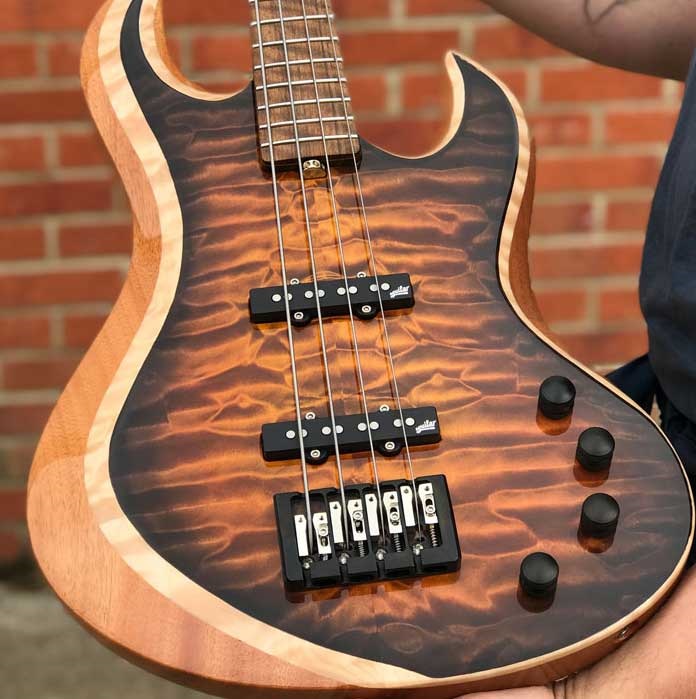Ray-Lin asked on Facebook:
I was wondering if you could talk about the difference between standard strings, taper core strings and exposed core strings?
“Standard” means “conventional construction”, which means “roundwound” (or “full contact”) string.
Taper-Core is where the outer wrap ends at the bridge, leaving only the inner wrap left, and that inner wrap is what passes over the bridge saddles. (To note: The term “Taper-Core” is a bit misleading, as you’re technically not passing any exposed core over the saddle. A more appropriate term would be “Taper-Wrap”, but everyone knows it as “core”, so that’s what it’s called.)
Exposed-Core is similar to Taper-Core, except only the core passes over the bridge saddles.
What’s the difference between these string types?
Taper/Exposed-Core primarily does two things.
First, “core” type strings can help with string articulation. For example, if you wanted a string where you could have more pronounced accents, taper/exposed-core can help out with that – maybe. I’ll talk more about that in a moment.
Second, if your bass has intonation issues, taper/exposed can help out a great deal, but again – maybe.
Knowing your core
There’s the thing called core-to-wrap ratio, which relates to the size of the core and the size of the wrap around said core.
Small core + big wrap = bright sound, however the tradeoff is a shorter note decay (which you would recognize as “less sustain”). And on top of that, that type of string typically won’t stay in tune as well.
Then there’s the actual shape of the core itself to take into consideration, which is either round or hexagonal. Hex-core is typically stiffer than round-core. But then of course the wrap around that core affects the sound as well. Nickel-plated is typically “darker”; stainless steel is typically “brighter”.
If the string type you want is “stiff-feeling and bright-sounding”, you’d want a string with a hex-core and stainless steel wrap around it. If you wanted “looser-feeling and dark-sounding”, you’d want a string with a round-core and nickel-plated wrap around it.
Knowing the core type is important because it directly affects the stiffness of the string when tuned to pitch. And yes, you will feel the difference between round-core and hex-core. Neither core type is better than the other; it’s a matter of player preference.
In plain English: If for example you tried a taper-core string with round-core on the inside, and it feels like it’s “flopping around” too much when you play, a hex-core won’t “flop” nearly as much because it’s stiffer.
What you need to know about taper/exposed-core is…
The first thing to know with any exposed or taper-core string is that it’s not a magic cure-all for note decay and/or intonation issues.
Fact: On some bass guitars, using taper/exposed-core can make the instrument sound terrible, and by terrible I mean “makes it sound cheap”. You’d know it if you heard it. But I want to make very clear that this only affects some bass guitars and certainly not all. Most of the time you can install taper or exposed-core strings and your bass will play and sound just fine – but that’s obviously not guaranteed.
The second thing to know is that long note decays are not the be-all/end-all of what makes a bass guitar “good”. It could very well be that conventional roundwound, while certainly not the “longest sustaining” string, is in fact the best string type for your particular bass guitar just to get it sounding and feeling right.
The third thing to know is that if switching from conventional roundwound to taper-core or exposed-core or vice-versa, you will have to adjust your playing style. Whether you’re a soft or a hard player, the string is going to feel different and the sound you produce from them will also take some getting used to.
Are all taper and exposed-core strings all basically the same no matter which brand is used?
Absolutely not.
Certain string companies use their own designs for construction, and then enter into agreements with other string companies not to copy their construction style. Basically what this means if that you plan on experimenting with roundwound, taper-core and exposed-core, you will have to spend some money to do it.



I would have said the two fundamental types are rounds and flats. Then there is a hybrid called half rounds or ground rounds.
Good info about the tapers, but leaving out flats is a significant omission. Some players use nothing else.